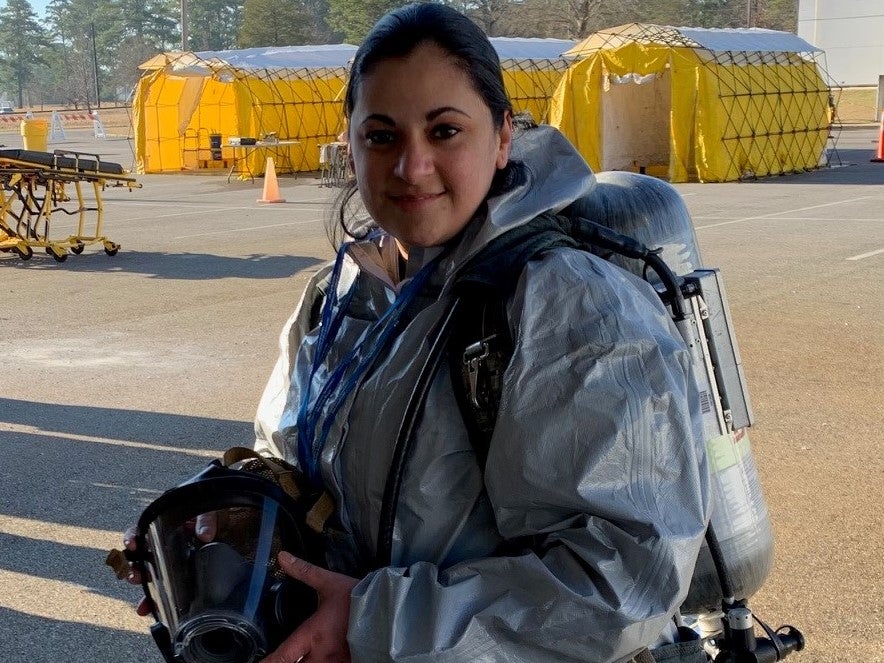
Alumni spotlight: Flight nurse saw value of learning emergency preparedness, today is disaster program manager
Melissa Abramowicz’s career had literally already taken off by the time she enrolled in the Master of Arts degree program in emergency management and homeland security (EMHS) at ASU. She had been in a successful career as an emergency/trauma and critical care flight registered nurse.
The time assisting patients in the skies attracted the Hawaii resident to studying EMHS online at the Watts College of Public Service and Community Solutions. Within weeks of her May 2021 graduation, the American Red Cross hired her as a disaster program manager.
Learn more about Abramowicz’s new job and about the recent natural disaster in Hawaii that led her to pursue the master’s degree that helped her get hired:
Question: Tell us a little about yourself today and your early years.
Answer: I have lived in many places, but even though I was born in New York City, Hawaii is my home. Living on an island with limited resources makes you appreciate the small things and want to better yourself in order to give back to the community you’re a part of. Hawaii is paradise, but Mother Nature knows no boundaries.
I graduated from the Watts College of Public Service and Community Solutions in May 2021, receiving a Master of Arts degree in emergency management and homeland security with a concentration in biological threat analysis. Before obtaining my master’s, I completed a bachelor’s degree in nursing and practiced as an emergency/trauma and critical care flight registered nurse. I am also a certified forensic nurse (FNE) and legal nurse consultant (LNC).
During my time as a nurse, I had the opportunity to join the National Disaster Medical System’s Disaster Medical Assistance Team, which led me on the road of emergency management. I fell in love with the many aspects of disaster medicine, emergency preparedness and response. After graduation, I submitted employment applications for a few different roles for emergency management. I received my first job interview in late May, was offered a position and began working as a disaster program manager for the American Red Cross on June 28.
Q. Talk about your responsibilities and what skills you learned in the EMHS program that apply.
A. A disaster program manager is responsible for leading and managing a primarily volunteer team to support and provide disaster workforce engagement in an assigned geographic region. This position serves as the lead functional expert for supporting a disaster response, and tailoring national program offerings by providing technical expertise, training and leading the disaster workforce. Some specific functions include program implementation, team building, team leadership, supervision, personnel development, workforce training, workforce engagement, deployment, GIS interpretation and representing the entire disaster cycle of preparedness, response and recovery. I learned all these skills and many more through the EMHS program at ASU.
Q. Were there professors you found to be great mentors to you? Tell us about how they were valuable to your academic and professional experience.
A. The professors and staff at ASU were fundamental to my success. They are the experts on the field and great mentors. The program is designed for working professionals and the staff is extremely helpful and eager to help. The COVID-19 pandemic provided many challenges throughout the school calendar year and yet, the staff was able to provide flexibility and adjust to the many changes without delaying or altering the timeline. They were very understanding and provided guidance for first responders like myself.
Q. What was your “aha” moment, when you realized you wanted to study the field you majored in?
A. In 2018 the Mount Kilauea volcano erupted on the Big Island of Hawaii. As a first responder living in Hawaii, I had the opportunity to witness firsthand the many challenges our community encountered during this disaster response. I became obsessed with preparedness and community advocacy. My community responded positively and during the same year I was able to involve them in participating with the Rim of the Pacific (RIMPAC) training. That year we focused on building resilience by having every island participate in a mass casualty exercise involving a military response. That is when I realized I could influence change and help others help themselves during a disaster event.
Q. Why did you choose ASU?
A. ASU’s EMHS program is interdisciplinary and nationally recognized. With the different available tracks, you can specialize in cybersecurity, biological threats or natural hazards. The program is flexible and tailored for working students. Not to mention, the career opportunities are endless.
Q. What’s something you learned while at ASU — in the classroom or otherwise — that surprised you, that changed your perspective?
A. I was surprised to learn that many of the professors are actively involved in the emergency management community in one way or another. I even had the opportunity to attend a conference in my community where one of my professors participated as an expert guest speaker.
Q. If you had college to experience all over again, what would you do differently? The same?
A. If I could do it all over again, I wouldn’t change a thing. Maybe I would not had waited this long to obtain my degree.
Q. In one sentence, what’s your life motto?
A. “Hardships often prepare ordinary people for an extraordinary destiny.” – C.S. Lewis
Mark J. Scarp is media relations officer for the Watts College of Public Service and Community Solutions. Photo courtesy of Melissa Abramowicz